 |
Geography
The Dead Sea Rift is an elongate depression, stretching along more than
1,000 km from northern Syria to the Red Sea in the south. The Jordanian
section along this depression includes the Gulf of 'Aqaba, the 'Araba
Valley, the Dead Sea and the Jordan Valley. The eastern boundary of
the Hashemite Kingdom of Jordan runs along the centerline of the Rift.

The
Dead Sea viewed from the
desert fortress of Mukawir (Itai Haviv)
The
Gulf of 'Aqaba is part of the Red Sea, which is a northern extension
of the Indian Ocean. Between the Gulf of 'Aqaba and the Dead Sea stretches
the 'Araba Valley, divided by a rather indistinct mid-valley watershed
into a northern section, which drains toward the Dead Sea, and a southern
section, which consists largely of mud flats and salinas. The lowest
part of the Rift is the Dead Sea, whose present shores lie at 410 m
below sea level.
The
Rift's flank east of the 'Araba Valley and the Dead Sea forms a steep
slope whose peaks reach 800-1,700 m above sea level. These peaks constitute
the edge of a wide plateau, which slopes gently eastward, towards the
interior of Jordan. West of the Dead Sea and the 'Araba Valley, the
western flank of the Rift rises to 500-1,000 m forming the Judean Mountains
and the Negev ranges.
The great difference in altitude between the bottom of the Rift and
the plateau to the east is responsible for a rugged terrain incised
by numerous deep canyons. Many of the canyons carry year-round streams
forming a sharp contrast to the arid environment.
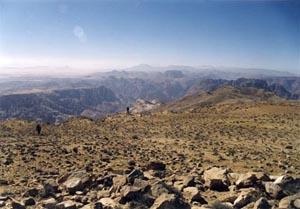
Deep
canyons carving their way
from
the highlands of Edom towards
the 'Araba Valley (Ittai Glaich)
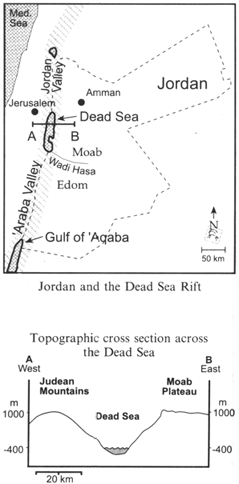
Two
geographical regions can be distinguished in Jordan between the northern
part of the Dead Sea and the Gulf of 'Aqaba. The northern region corresponds
to biblical Moab and the southern to biblical Edom. The transition between
these two regions is marked by Wadi Hasa, which was the border between
the kingdoms of Moab and Edom (12-6th centuries BCE). The highest peaks
of Moab rise to 1,300 m, while those of Edom reach 1,700 m. The plateau
of Moab was noted for its wheat and barley fields, whereas Edom was
more of a pastureland. Today, the municipal districts of southern Jordan
are no longer called Moab and Edom. The region of Moab includes the
districts of Amman and Karak and the region of Edom includes of the
districts of Tafila and Ma'an. The major cities in Moab today are Karak
and Madaba, while those in Edom are Tafila, Wadi Musa, Ma'an, and 'Aqaba.
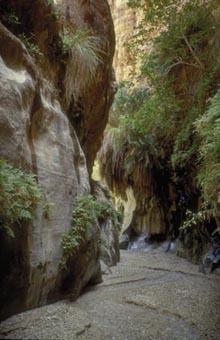
Hanging
gardens in the canyon
of Wadi 'Aima (Itai Haviv)
The
topography of the Rift dictates a steep east-west climatic gradient.
Clouds, which form over the Mediterranean Sea, are blown by prevailing
westerlies towards the Judean mountain ridge. As they move over the
rising land, they cool and eventually precipitate, dropping most of
their load over the ridge of Jerusalem, Bethlehem and Hebron (450-700
mm). Moving further eastwards, the clouds descend towards the bottom
of the Rift, warm up and hardly yield a drop of rain (20-90 mm per year).
When the eastwards drifting clouds are driven up the edge of the Jordanian
plateau, they precipitate once more (300-500 mm in the vicinity of Madaba
and Karak) before fading away over the desert to the east. Due to the
north-to-south regional aridity gradient most of Edom receives less
rainfall than Moab. This pattern of rainfall leaves Jordan with an arid
desert covering more than three-quarters of the country. Only a narrow
stretch along the peaks of the plateau receives adequate amount of seasonal
rainfall. Consequently, there are very few permanent settlements along
the Dead Sea and the 'Araba, and none along the steep slopes of the
Rift.
The
climate of Jordan is a mixture of desert and Mediterranean climates.
Winter is cold and rainy and summer is hot and dry. However, the east-west
climatic gradient makes it possible to enjoy comfortable weather conditions
in the bottom of the Rift during the winter as well as in the elevated
areas during midsummer.
Three
main roads run the length of Jordan from north to south. The lowest
road runs along the Dead Sea shore and the 'Araba Valley. High up, on
the upper reaches of the steep slope, lies the historic King's Highway.
Transverse roads and tracks connecting these two meridional routes are
few, and their grades are very steep. On the plateau to the east is
the Desert Highway - the fastest way to travel the length of Jordan.
Exploration
of the Jordanian Dead Sea Rift
During most of the Ottoman period, anarchy prevailed throughout Jordan
and Palestine, and security conditions were very poor. It was only in
beginning of the 19th century that a few daring explorers first ventured
into the wild region east of the Jordan River and the Dead Sea, motivated
by the will to discover the lands of the Bible. The charm of the Orient,
as well as the spirit of adventure, soon attracted many travellers,
researchers and artists. Though they carried arms and had Bedouin escorts
they still faced tremendous difficulties.
| |
"Towards
sunset we reached the Samrat el Fidan, a long, low mountain ridge,
on the eastern slopes of the 'Araba, where we intended to encamp.
Just before entering it, we espied a company of Arabs, armed and
mounted on camels and preparations were at once made in case of
an attack by the strangers. Our own camels were drawn aside beneath
the shelter of a rock; each of the party examined his arms and
prepared to use them if necessary… there is something rather pleasant
in the uncertainty and excitement of such a moment, though we
were not sorry to see both parties embrace, and to find that the
new comers were members of the same tribe." (E. H. Palmer, 1868)
|
|
Ulrich
Jasper Seetzen, 1806-1807
The German doctor Seetzen was the first known western explorer to travel
through Jordan since the Crusaders. He travelled under the name Musa
el Hakim, spoke fluent Arabic and was a convert to Islam. His first
journey through Jordan took him along the King's Highway to Karak and
then down to the Dead Sea shore. He crossed the outlet of Wadi Hasa
and skirted the southern tip of the Dead Sea. On a later journey, Seetzen
walked along the entire eastern shore of the Dead Sea! He insisted on
following the lake's shoreline even where his Bedouin guides declared
it to be impossible.
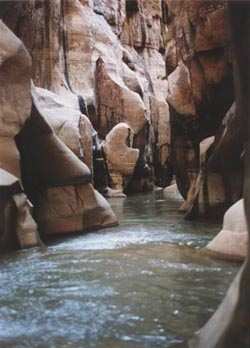
The
gorge of Wadi el Hidan (Shai Reuveni)
More
than 40 years after Seetzen the traveller De Saulcy (1851) wrote about
the difficulties of walking along the Dead Sea shore:
| |
"Before
starting we had held a council with the sheikhs of our escort,
for the purpose of selecting the route we were to follow throughout
the day. They told us that it was practicable enough to push on
as far as the bank of Wadi Mujib, meaning the Arnon, but that
we should not be able to ford that river, and besides, were we
to succeed, we should find beyond it a beach so narrow as to be
impassable."
|
|
Seetzen
is the first to describe Wadi Mujib's lower gorge. Among his many discoveries
were the warm springs of Wadi Zarqa Ma'in, Callirhoe (Hammam ez-Zara')
and the fortress of Machaerus. Although he travelled through unknown
land he did not stick to main routes. It was many years before others
walked along paths that he had trod. Seetzen was murdered in Yemen in
1811.
John
Louis Burckhardt, 1812
The
Swiss traveller Burckhardt is renown for discovering Petra to the western
world. Disguised as a Muslim who had vowed to sacrifice a goat at the
tomb of Aaron, he ventured into the ancient city and published a detailed
description of the site. Burckhardt was the first to travel through
Edom. After his visit to Petra it became the dream of many travellers.
L.
E. Laborde, 1828
A French explorer who travelled through Edom and Sinai disguised as
a Bedouin. Unlike Burckhardt he travelled in style with a caravan of
sixteen camels. Laborde was the first to approach Petra from 'Aqaba
through the southern part of the 'Araba Valley. On his return journey
from Petra to 'Aqaba, he visited Wadi Sabra and the Nabataean site Humeima.
Laborde was later appointed director of the Louvre Museum in Paris.
His sketches of Petra illustrated the region for many scholars and armchair
travellers.
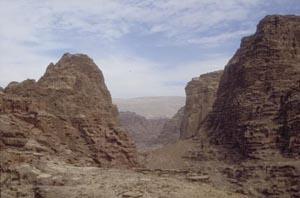
Wadi
Tajra and the cliff of Umm Ala (Itai Haviv)
Lord Lindsay, G. H. Von Schubert, G. H. Moore and W. G. Beke 1837
The
Englishman Lindsay and the German Von Schubert travelled shortly after
each other through the whole length of the 'Araba Valley. Schubert was
among the first to realize that the Dead Sea and parts of the 'Araba
Valley were much lower than global sea level. At about the same time,
Moore and Beke reached the same conclusion. The discovery was a scientific
sensation.
D. Roberts, 1839
The artist David Roberts is renown for his paintings of Petra as well
as of many other historic sites in the region. His work reached a much
wider public than the accounts of his predecessors.
W. F. Lynch, 1848
Captain Lynch headed an official exploration party of the American Navy,
which negotiated the length of the Jordan River from the Sea of Galilee
to the Dead Sea. The Lynch expedition produced an accurate map of the
Dead Sea with many of its adjoining canyons.
During
the second half of the 19th century many travellers and researchers
visited Moab and Edom. These included the English clergyman and naturalist
H. B. Tristram and the Czech explorer Alois Musil. The most explored
route was along the King's Highway, though some travellers also visited
the Dead Sea and the 'Araba Valley. Thus, we have descriptions of the
upper reaches and the outlets of many canyons that flow into the Rift
Valley. However, the long, jagged belt between the King's Highway and
the bottom of the Rift remained only lightly explored. Transverse routes
from east to west were few, steep and dangerous. Obviously, walking
through flowing canyons, which were impassable to pack animals, was
out of the question. Moreover, since the main motivation for explorations
was identifying biblical sites, the canyons and the rugged peaks hardly
drew any attention. For the last fifty years the access to the 'Araba
Valley and the Dead Sea was limited due to their proximity to the border
with Israel. There was even no tarred road along the northeastern shore
of the Dead Sea until the early 90's. The 1994 peace agreement with
Israel made the Rift Valley considerably more accessible. Nevertheless,
even today there remains much which is still unexplored.
Top of the page
|
 |